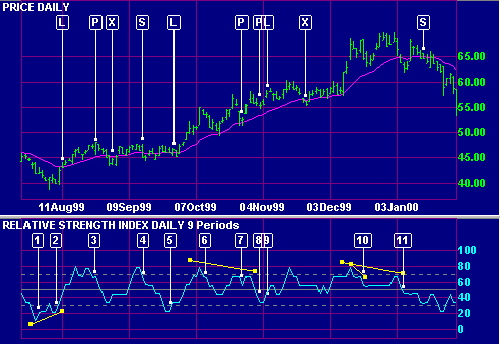Relative Strength Index
Relative Strength Index (RSI) is a popular momentum oscillator developed by
J. Welles Wilder Jr. and detailed in his book New Concepts in Technical
Trading Systems.
The Relative Strength Index compares upward movements in closing price to
downward movements over a selected period. Wilder originally used a 14 day
period, but 7 and 9 days are commonly used to trade the short cycle and 21 or 25
days for the intermediate cycle. Please note that Wilder does not use the
standard moving average formula and the time period may need
adjustment.
Relative Strength Index is smoother than the Momentum or Rate of Change
oscillators and is not as susceptible to distortion from unusually high or low
prices at the start of the window (detailed in
Momentum Construction). It is also formulated to fluctuate between 0 and
100, enabling fixed Overbought and Oversold levels.
See
Construction for further details.
Trading Signals
Different signals are used in
trending and
ranging markets. The most important signals are taken from overbought and
oversold levels,
divergences and
failure swings.
Use
trailing buy- and sell-stops to time entry into trades.
Ranging Markets
Set the Overbought level at 70 and Oversold at 30.
-
Go long when RSI falls below the 30 level and rises back above it
or on a bullish
divergence where the first trough is below 30.
-
Go short when RSI rises above the 70 level and falls back below it
or on a bearish
divergence where the first peak is above 70.
Failure swings strengthen other signals.
Trending Markets
Only take signals in the direction of the trend.
-
Go long, in an up-trend, when RSI falls below 40 and rises back above it.
-
Go short, in a down-trend, when RSI rises above 60 and falls back below
it.
Exit using a trend indicator.
Take profits on
divergences. Unless confirmed by a trend indicator, Relative Strength Index
divergences are not strong enough signals to trade in a trending market.
Example
Wal-Mart Stores Inc. is plotted with a
 21 day
exponential moving average (MA) and
21 day
exponential moving average (MA) and  9 day Relative Strength Index. A 2-day closing
filter is used with the MA.
9 day Relative Strength Index. A 2-day closing
filter is used with the MA.

- Price is trending downwards (staying below the moving average). Do not
take long signals until the MA turns upward, otherwise we are trading against
the trend.
- A bullish
divergence on Relative Strength Index is reinforced by completion of a
failure swing at [2]. Go long [L] when the MA slopes upwards and RSI
crosses to above 40.
- RSI completes a minor failure swing at [3]. Take profits [P] and exit the
remaining position [X] when there are two closes below the MA.
Do not go short as price is trending upwards (staying above the moving
average).
- Price has started to fluctuate around the moving average, signaling a
ranging market. Go short [S] when RSI crosses from above to below 70.
- Go long [L] when RSI crosses from below to above 30.
- There has been a breakout from the trading range and price is trending
upwards. Do not close the long position.
- Take profits [P] on the bearish divergence (Price has completed a higher
peak while RSI has experienced a lower peak).
- Take profits [P]. A bearish
triple divergence is confirmed by completion of a large failure swing at
[8].
- Increase your long position [L]. RSI has crossed from below to above 40
during an up-trend.
Exit your position [X] when there are two closes below the MA. Do not go short
as the MA still slopes upwards.
- A small bearish divergence warns of a possible trend reversal.
- A bearish
triple divergence is reinforced by completion of a
failure swing at [11]. Wait until the MA has turned down and RSI has
crossed to below 60 before entering a short trade [S].
Setup
See
Indicator Panel for directions on how to set up Relative Strength Index.
The default RSI window is set at 14 days with Overbought/Oversold levels at
70% and 30%. To alter the default settings - see
Edit Indicator Settings.
Related Topics
RSI Construction
First, decide on the indicator period. Then, compare closing price [today] to
Closing price [yesterday]...
External Links
Technical Charting Archives : January 07, 2000
The Relative Strength Index
The Relative Strength Indicator (RSI)
Relative Strength Indicator
Relative Strength Index (RSI) -- Chart School
RSI is a momentum oscillator that compares the magnitude of gains against the
magnitude of losses.
Technical
Analysis from A to Z
Relative Strength Index - Steve Achelis' best-selling book, Technical Analysis
from A to Z
![]() 21 day
exponential moving average (MA) and
21 day
exponential moving average (MA) and ![]() 9 day Relative Strength Index. A 2-day closing
filter is used with the MA.
9 day Relative Strength Index. A 2-day closing
filter is used with the MA. 